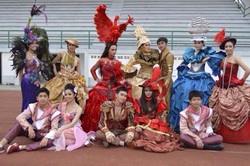 The costumes are astounding. That’s all there is to it. They are amazing, and they transform those who wear them into fantastic beings, quite above mere mortals. I admit I am impressed by the productions and fascinated by the cultural values that support them. I am delighted with the producer, too. Wi, whose real name is Chanon, grew up nearby. He went to school here and then decided to turn his creative flair into a career. For a few years he and his partner manufactured terra cotta garden figurines that sold well in Europe until the EU had an economic stumble. Wi and Nick then turned to costumes. Five years on, the “Showtime Collection Costume Shop” has a stock of hundreds for rent with scores more sold around the world. For a farmer’s son who was too poor to finish school, Wi is doing well. There is competition, of course, among costume shops but Wi has cornered the high-end market. At the age of 31 Wi is modestly wealthy. The key to his success is his talent for designing glamorous fantasy ensembles. He is hired to provide attire and make-up for amateur groups performing at fund-raising events, music contests, festivals, and at high school and college parties and celebrations. These days the budgets for groups run into five figures and the costumes are often custom-made by teams of seamstresses Wi directs. The question is “why?” The simple answer is that the events are fun. It is fun to step outside ordinary affairs and into the spotlight. In Thailand “fun” (sanuk) is a compelling motive for every successful undertaking including physical labor and even funerals. But there is a deeper level of satisfaction for the performers and their sponsors. What is the nearly universal drive of so many in this generation to acquire alternative characterizations? For some, these are occasional excursions into realms of fantasy. This aspect of Wi’s business is indicated by the word “showtime” in the name of his shop. The collection of costumes rival (or mimic) ideas from LasVegas and carnivals in Rio and New Orleans. They are creations of plumage and textiles attached to frameworks, exquisitely engineered. With the focus on the costumes, all that needs to be acquired by the performers is a degree of syncopation. For an easily distracted generation of young people this sort of temporary stardom is an agreeably short trip. Sponsors expect a return for their investment. This is not like a contribution for blankets for villagers in the mountains or for refurbishing a temple, where helpfulness, compassion and merit are the pay-offs. The sponsors expect credit. They and the performers want pictures. Whether the event is a sales campaign or a centennial celebration, the photo-record needs glamour. Post-modernism has deconstructed the big picture and serves it back as fragments in a random pattern. A connection is not implied. An attempt to reconstruct the “whole thing” is apt to be disappointing. The design needs care, but the content can be just about anything. In a photo-montage extra-close-ups and panoramas, garish colors and subdued hazy views coexist. There is nothing inconsistent about Wi’s costumed dancers sharing the stage at a sports-medal award night. In the overall school experience being splendid for a night nicely complements whatever the main event may have been, and these days all those diverse efforts demand to be considered valid.
0 Comments
Leave a Reply. |
AuthorRev. Dr. Kenneth Dobson posts his weekly reflections on this blog. Archives
March 2024
Categories |
| Ken Dobson's Queer Ruminations from Thailand |
|
 RSS Feed
RSS Feed
